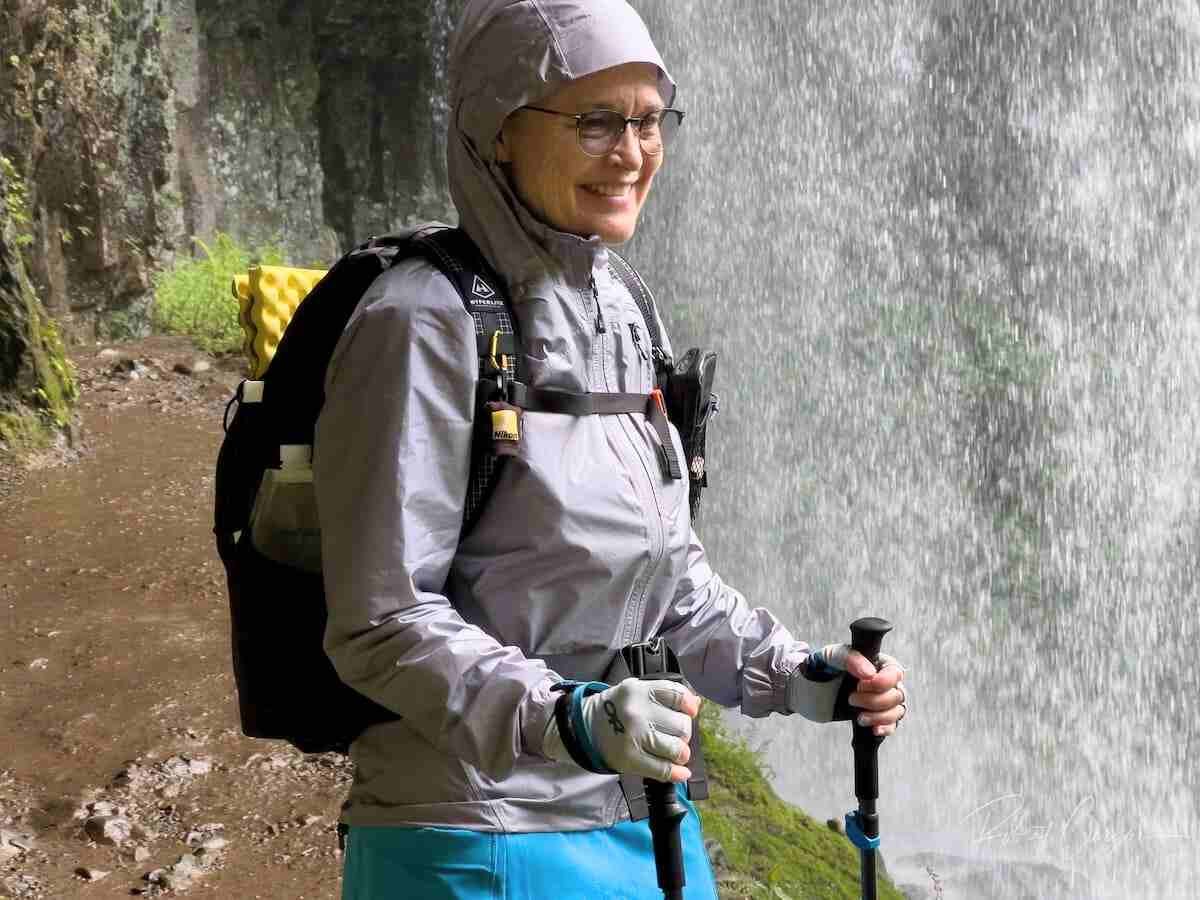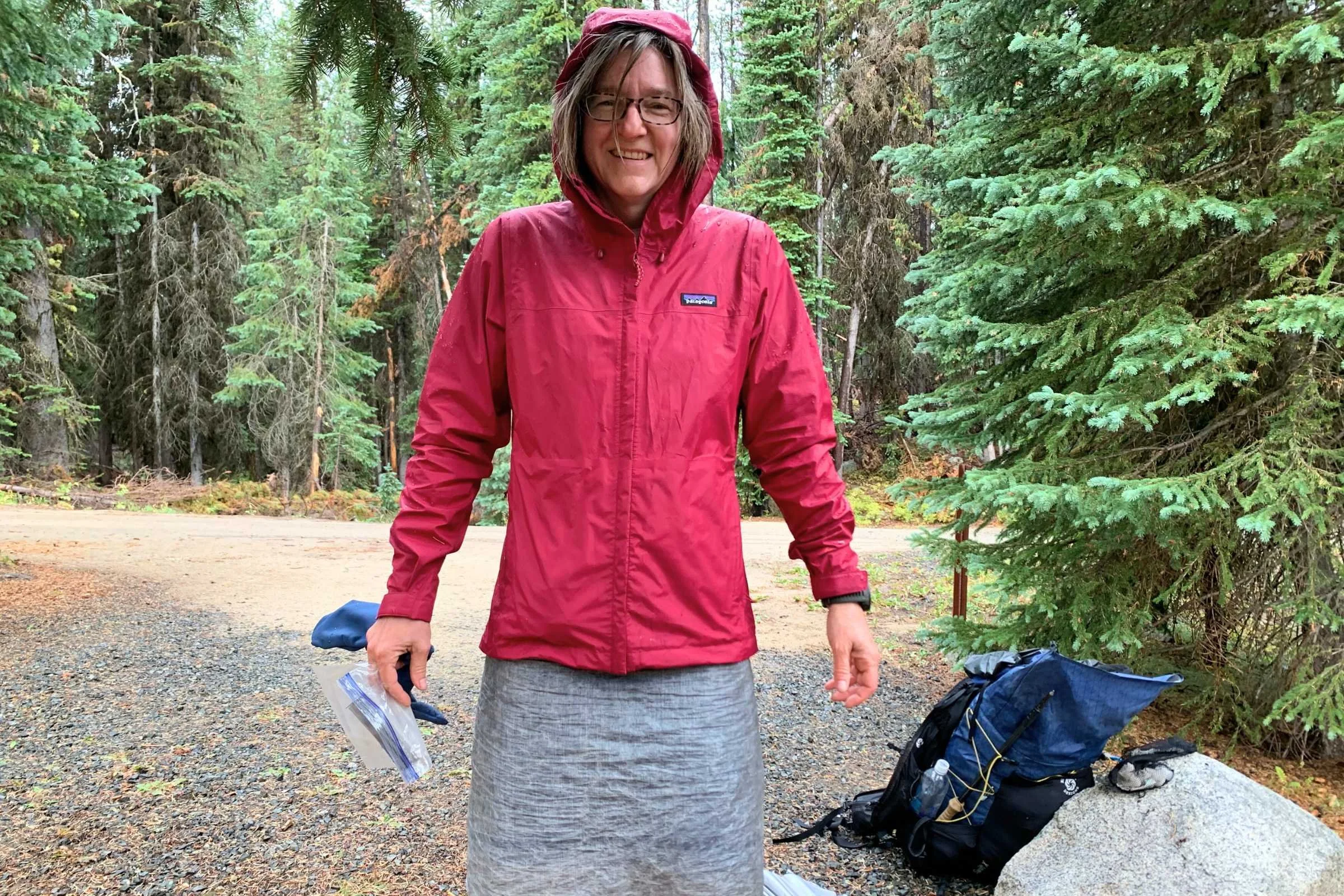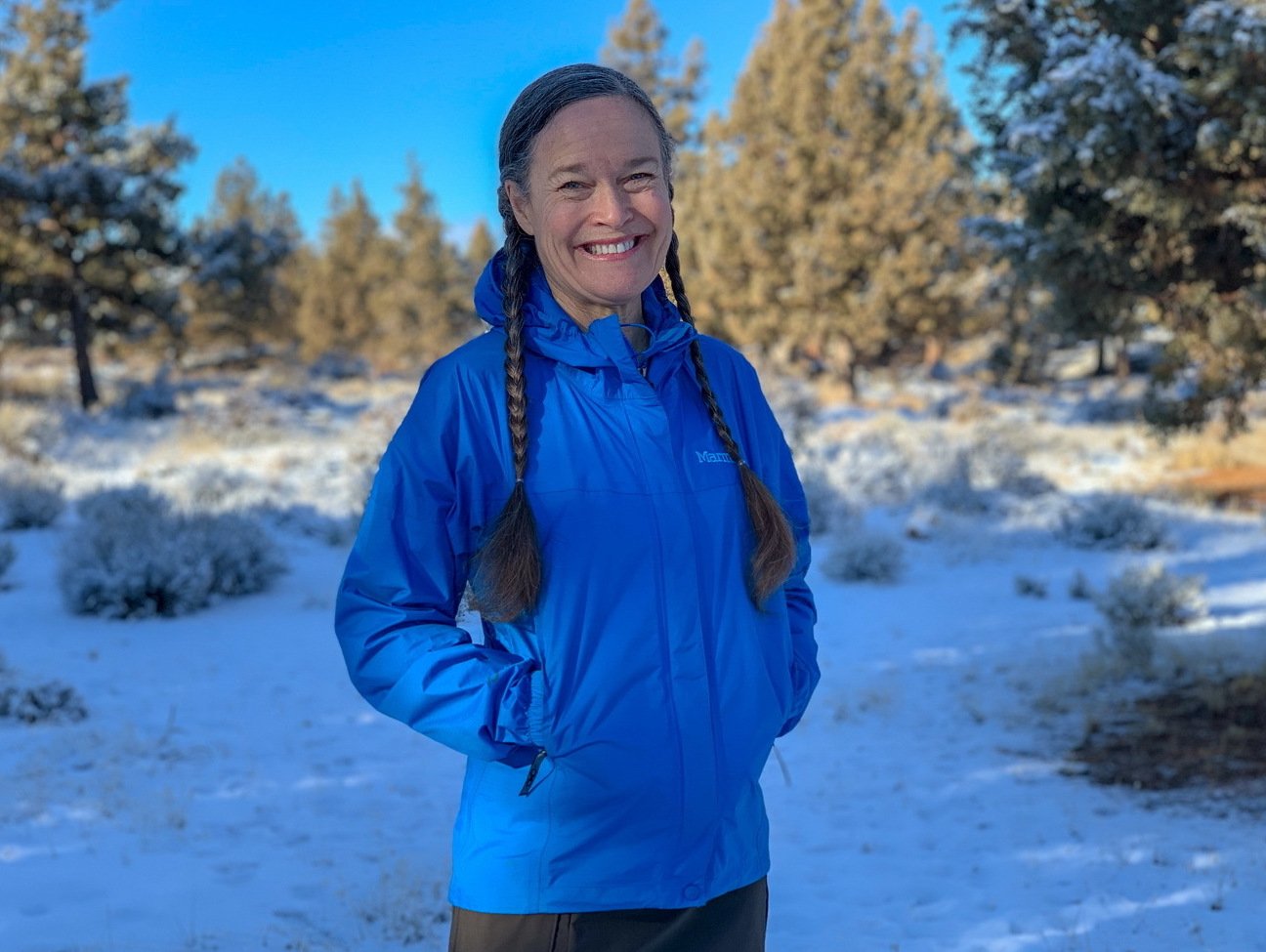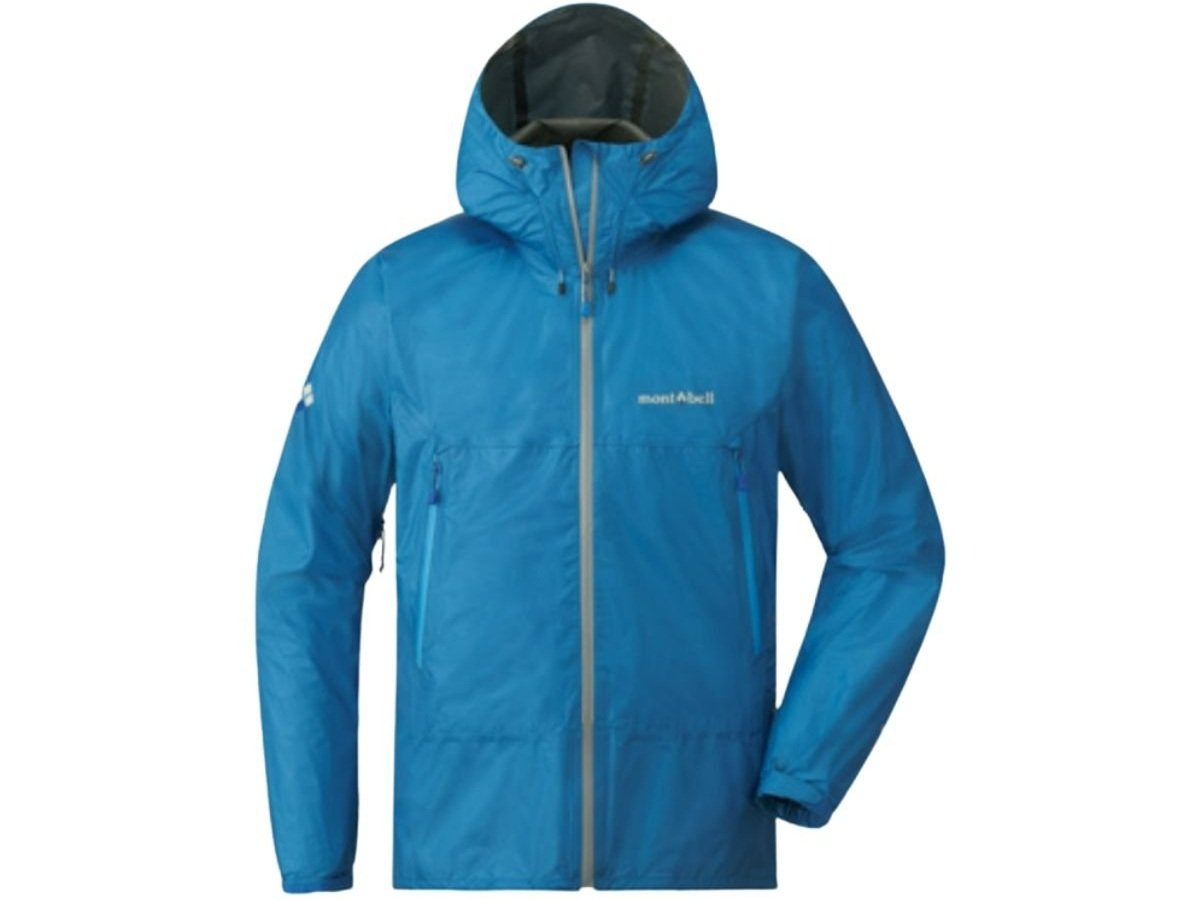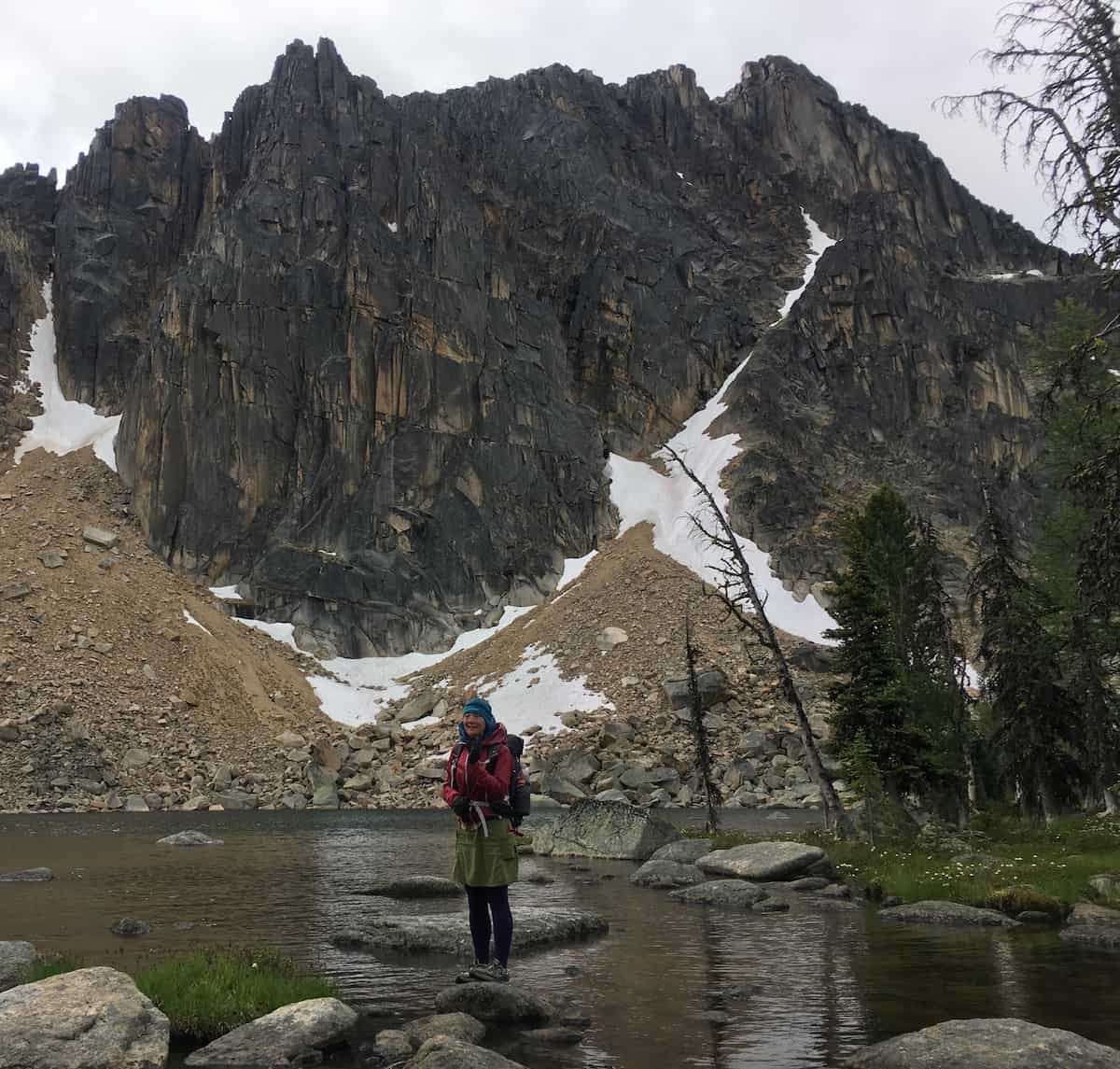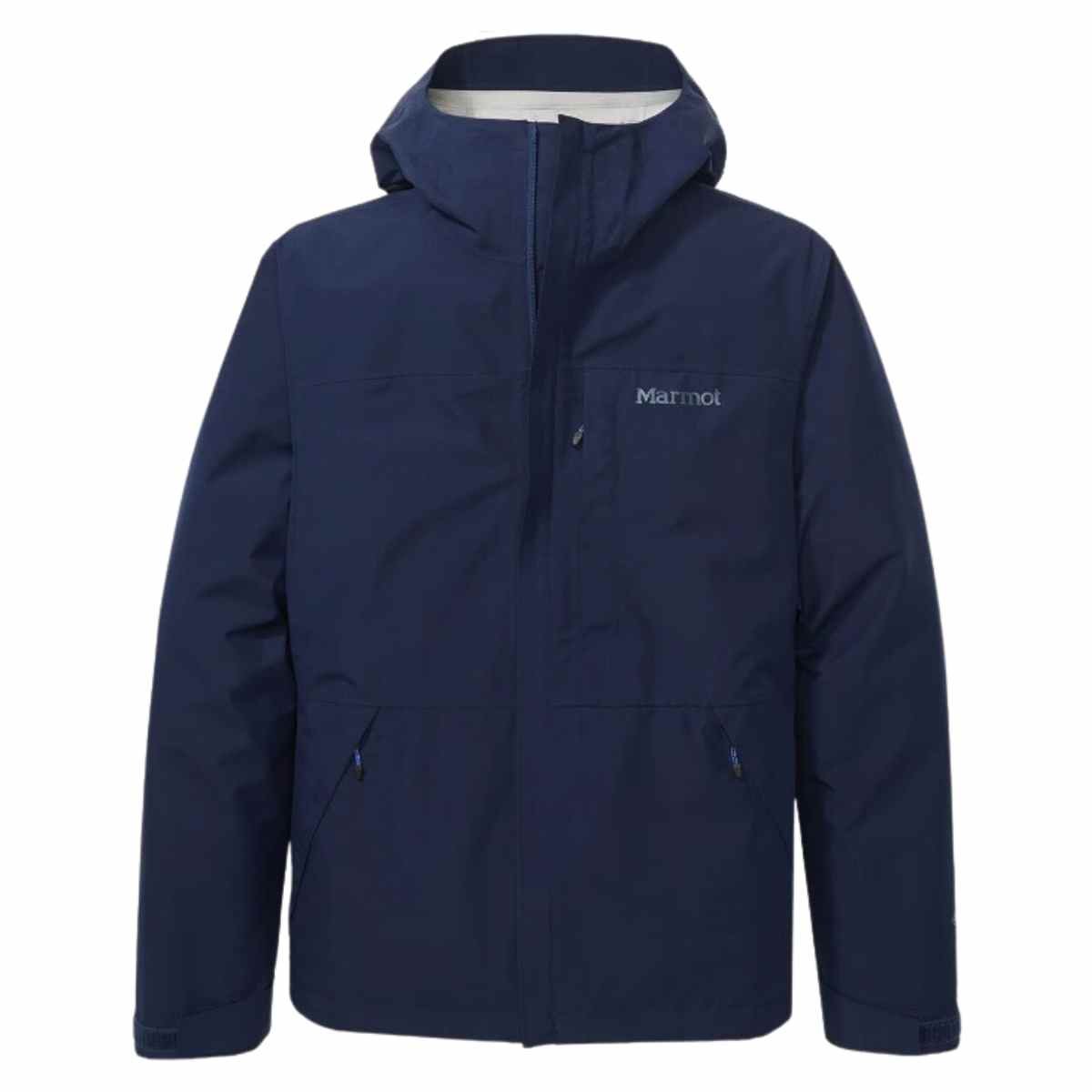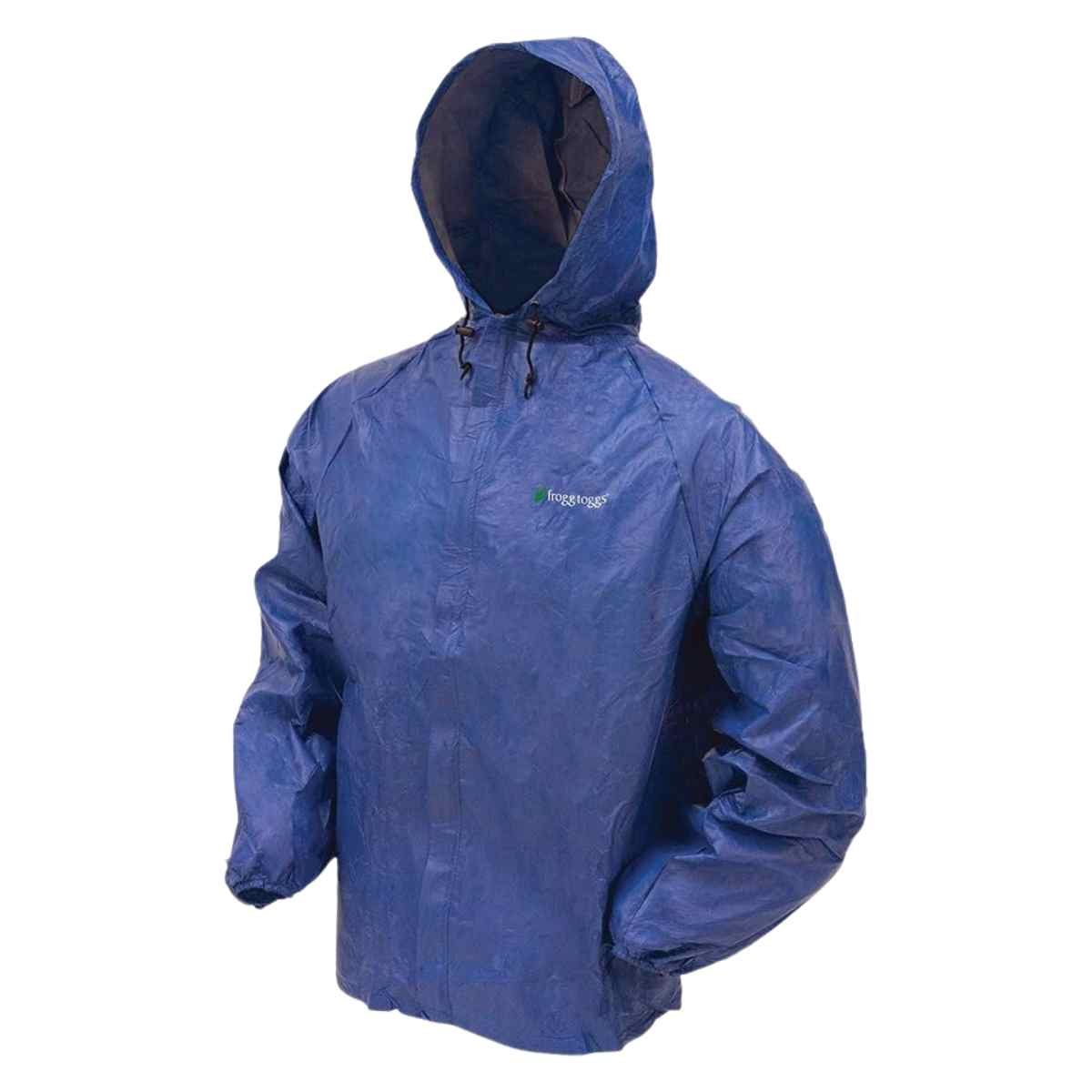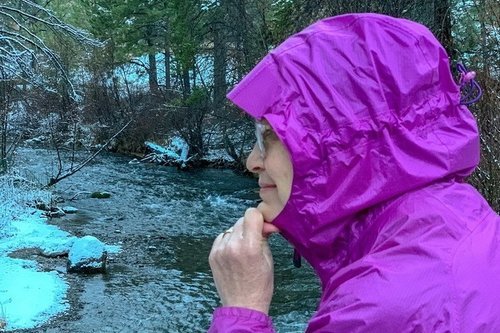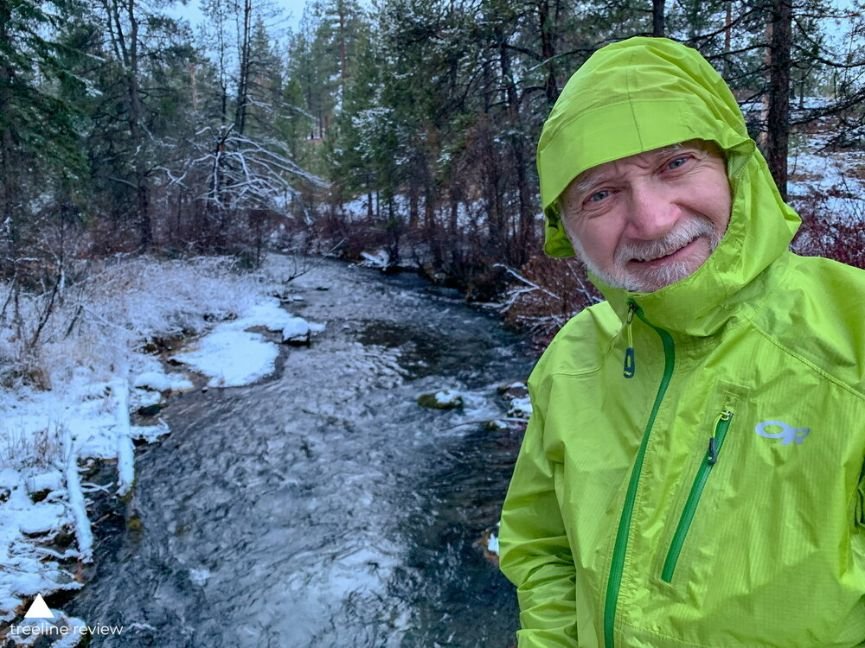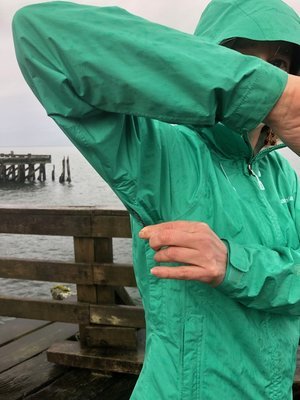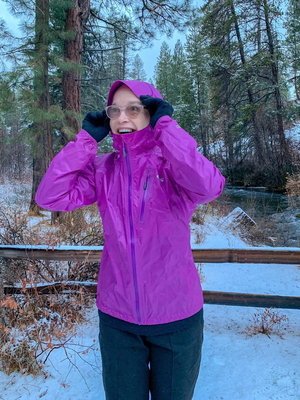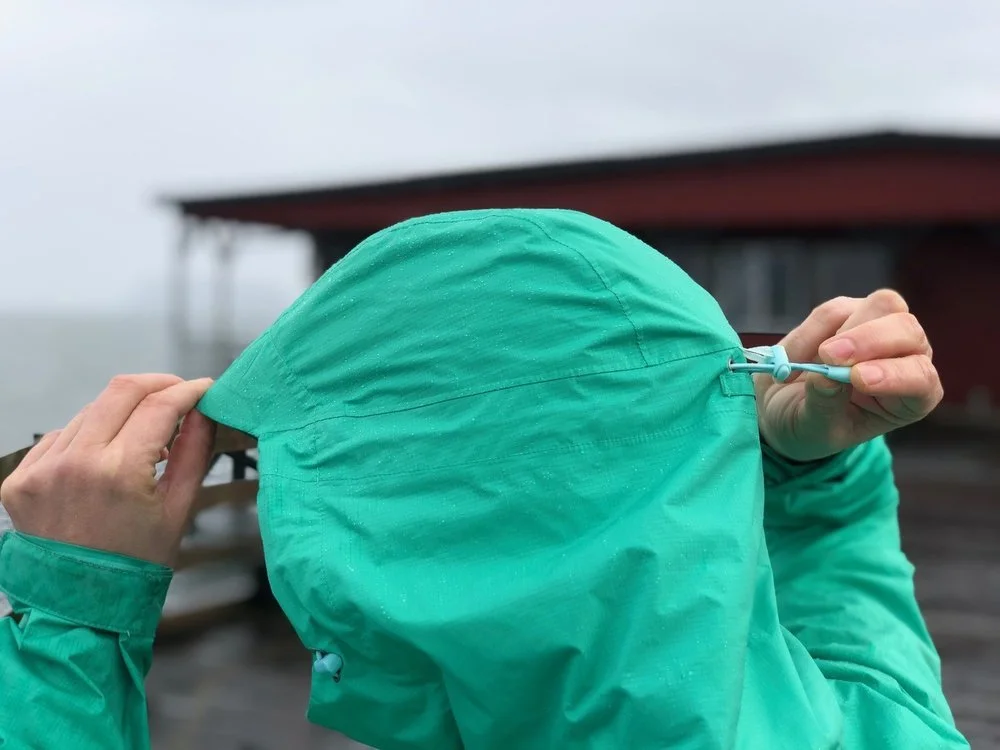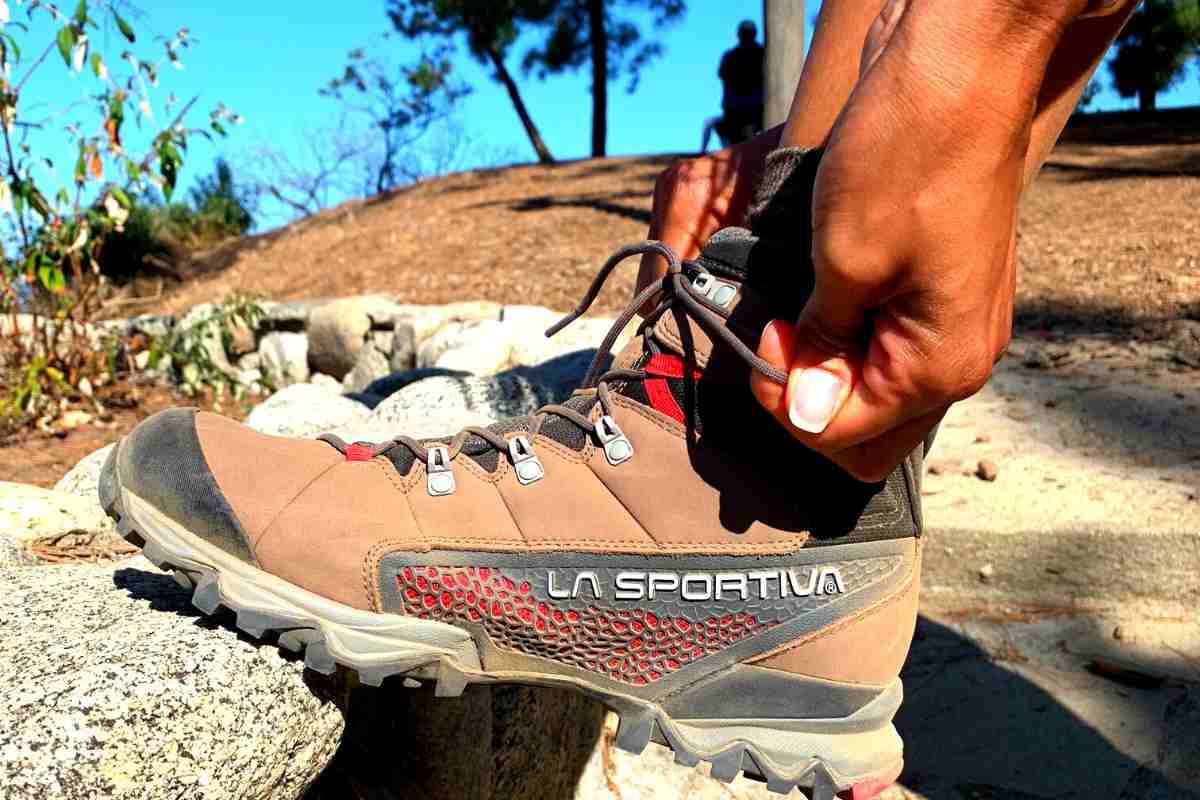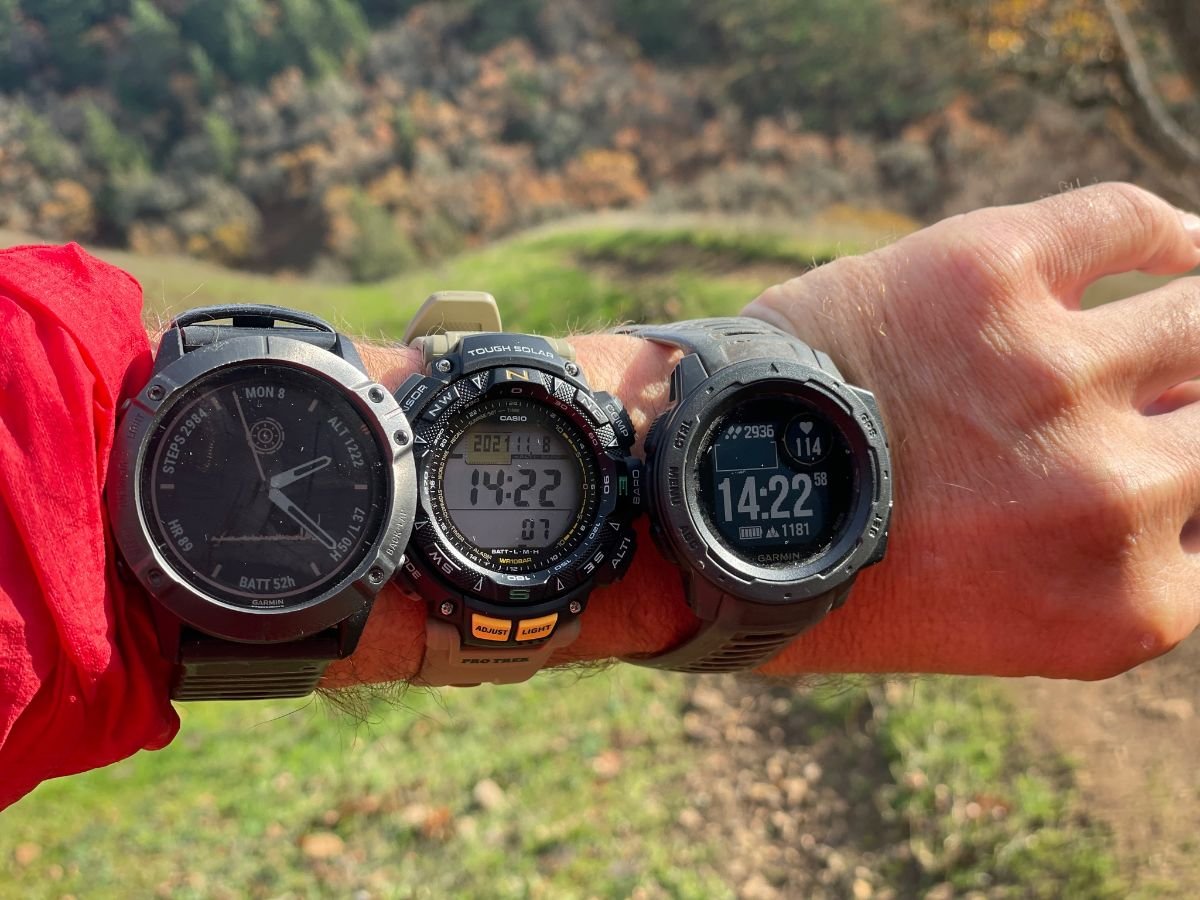Best Lightweight Rain Jackets of 2025
Waterproof rain gear for Hiking, Backpacking, Travel, and Commuting
Updated March 12th, 2025, with winners having PFC-free and PFAS-free waterproofing, more info about size availability
Home > Gear Reviews > Apparel
After reviewing 81 lightweight breathable rain jackets, we spent 5 years testing the most promising from the rainy Pacific Northwest to the Appalachian Trail. Our goal is to find the best lightweight rain jackets for most hikers, runners, travelers, and commuters.
Since we were evaluating lightweight rain jackets in this gear review, pretty much everything we tested would win for best packable rain jacket. Instead, we looked for rain jackets with a secure adjustable hood, solid waterproof seams, and good durable water repellent (DWR) coatings. For 2025 to comply with new laws, all the jackets we recommend have PFC-free and PFAS-free waterproofing to be eco-friendly.
After analyzing more than a dozen outdoor magazine gear reviews and hundreds of customer reviews, we purchased the most promising rain jackets. Then we tested them in the Pacific Northwest, such as the Oregon Coast Trail all the way to the Appalachian Trail, and in conditions from drizzly daily commutes to mountaintop downpours.
In this gear review, you'll find recommendations for all kinds of rainy conditions. If you’re looking for a great all-around waterproof rain jacket, we like the Patagonia Torrentshell 3L as a high-performing, durable option at a mid-range price. We also found the best rain jackets for people on a budget, fast-and-light ultralight backpackers, and commuters looking for a workhorse rain jacket—and everyone else who hikes or walks in the rain.
We create reader-supported, objective gear reviews independently selected by our editors. This story may contain affiliate links, which help fund our website. When you click on the links to purchase gear, we may get a commission, without costing you an extra cent. Thank you for supporting our work and mission of outdoor coverage for every body! Learn more.
Rain Jacket Model Comparison Tables
Men’s
| MEN'S RAIN JACKET | TREELINE AWARD | WEIGHT (OZ) | WATERPROOF MEMBRANE | WATERPROOF RATING | PIT ZIPS | POCKETS | SIZES |
|---|---|---|---|---|---|---|---|
| Patagonia Torrentshell 3L | Best Overall Read why |
14.1 | H2No 3L | 20,000mm | Yes | 2 | XS-XXXL |
| Arc'teryx Beta SL Jacket | Best Upgrade Read why |
13.9 | 3-layer GORE-TEX | 28,000 mm | Yes | 3 | S-XXL |
| Black Diamond FineLine Stretch | Most Comfortable Read why |
11.3 | 2.5L BD.dry | 10,000mm | Yes | 2 | XS-XXXL |
| Ultimate Direction Ultra Jacket | Best Running Rain Jacket Read why |
6.56 | 2.5 Layer Proprietary waterproofing | 30,000mm | Vents | 1 | S-XL |
| Outdoor Research Helium | Best Packable Read why |
7 | Pertex Shield Diamond Fuse 2.5L | 15,000mm | No | 1 | S-XXXL |
Women’s
| WOMEN'S RAIN JACKET | TREELINE AWARD | WEIGHT (OZ) | WATERPROOF MEMBRANE | WATERPROOF RATING* | PIT ZIPS | POCKETS | SIZES |
|---|---|---|---|---|---|---|---|
| Patagonia Torrentshell 3L | Best Overall Read why |
12.5 | H2No 3L | 20,000 mm | Yes | 2 | XS-XXL |
| Arc'teryx Beta SL Jacket | Best Upgrade Read why |
9.5 | Gore-Tex Paclite Plus | 28,000 mm | No | 3 | XXS-XXL |
| Black Diamond FineLine Stretch | Most Comfortable Read why |
9.5 | BD.dry 2.5 L | 10,000 mm | No | 2 | XS-XXL |
| Ultimate Direction Ultra Jacket | Best Running Rain Jacket Read why |
5.82 | 2.5 Layer Proprietary waterproofing | 30,000mm | Vents | 1 | S-XL |
| Outdoor Research Helium | Best Packable Read why |
7 | Pertex Shield Diamond Fuse 2.5L | 15,000 mm | No | 1 | XS-4X |
| Marmot PreCip Eco | Best Budget Read why |
9 | NanoPro Eco | 10,000 mm | Yes | 2 | XS-3X |
| Mont Bell Versalite | Best Ultralight Read why |
5.8 | 2L Gore-Tex Infinium Windstopper | 30,000 mm | Yes | 2 | S-XL |
| REI Rainier | Best Plus-size Read why |
11.4 | Peak 2.5L | not stated | Yes | 4 | XS-XL |
| Marmot Minimalist | Best for Commuting Read why |
13.7 | Gore-Tex with Paclite 3L | 20,000 mm | Yes | 3 | XS-XL |
| ZPacks Poncho Grounsheet | Best Poncho Read why |
5.9 | Dyneema Composite Fiber | 20,000 mm | N/A | 0 | n/a |
* We note any discounts we see on our Deals page, which is updated daily.
The best lightweight rain jackets
The Best Lightweight Rain Jacket: Patagonia Torrentshell 3L
Best for: hiking, backpacking, trail to town, occasional commuting
PFC-free and PFAS-free: Yes
Sizes: XS-XXXL (men's), XS-XXL (women's), kids' and toddlers'
Weight: 14.1 oz (men’s), 12.4 oz (women’s)
Waterproof Material: 3-layer H2No
Waterproof Rating: 20,000+ mm/24 hours
Breathability Rating: Not stated
Pit Zips: Yes
Pockets: 2 zippered handwarmer pockets
What we liked: 3-layer waterproof jacket for a reasonable price, eco-friendly, lifetime warranty, well-featured with pockets, pit zips, versatility for town and trail
What we didn't like: heavier than many rain jackets
The Patagonia Torrentshell 3L is an extra-heavy-duty version of one of our former favorites—and it takes home top marks for a third year in a row. At 14.1 oz, it’s on the heavier side for jackets in this review, but it comes fully loaded with welted storm flaps over DWR-treated zippers, armpit zips for venting, hand pockets for stowing, and a two-way-adjustable, stowable hood (that doesn’t quite fit a helmet). As one of the most eco-conscious and waterproof jackets in our review, it’s a fantastic full-featured jacket for trail or town at the mid-range price of $179.
We think given its overall performance, value, wide availability of colors and sizes (including sizing up to XXXL and kids' sizing), the Torrenshell is the best lightweight rain jacket for most people for most situations.
Patagonia Torrentshell 3L
Men’s
Women’s
Torrentshell 3L vs 2.5 Layer
We’ve previously reviewed the 2.5-layer version of this jacket, and what you get with the added “half” layer is nothing to sneeze at. Our tester, Treeline editor Naomi Hudetz, tested both versions. While the weight penalty is minimal, the 3-layer H2No technology in the 100% recycled fabric offers enough additional weather resistance to impress. “I used the Torrentshell 3L on my Blue Mountains Trail thru-hike in September,” Naomi mentioned. “We had days of 35° F with steady rain-and I had no water intrusion at all.” She also thought it was great at keeping out cold gusts of wind along the way.
Also of note, the 3L is less clammy than its 2.5-layer counterpart. If you’ve ever had a lightweight rain jacket stick to your skin while wearing short sleeves, you know that it not only feels kind of gross, but it actually makes you colder. 3L jackets are designed to better move excess heat and sweat from the inside of the jacket to the outside—keeping you more comfortable in the process.
Hood and pockets
While Naomi was a little disappointed with the newest model's pockets—they’ve moved further down the jacket, and will sit under a hip belt if you’re wearing one—she loved the changes to both the hood and the pit zips. The hood is roomy and two-way adjustable, it now stows with a simple hook, and it features a fleece-lined neck for added comfort. Patagonia has also added another zipper to their pit zips, meaning more customizable ventilation and easier zipping and unzipping.
Eco-friendly fabric
If you’re thinking about your environmental impact, the Torrentshell 3L is one of the best jackets you can buy. While the manufacture of rain jackets, in general, can be harsh on the environment, Patagonia is considered the best in the outdoor industry for its practices and transparency when it comes to labor conditions and environmental responsibility.
They share their supplier information with consumers, including the specifics of how and where the Torrentshell is made.
The fabric is bluesign® approved, which is considered the highest standard in the industry to use methods and materials that minimize the impact on people and the environment. Bluesign works “at each step in the textile supply chain to approve chemicals, processes, materials, and products that are safe for the environment, safe for workers and safe for the end customers.”
To round it all out, the Torrentshell is made without perfluorinated chemicals (PFCs/PFAS) — including the durable water repellent (DWR) finish.
From its performance to its features, from its impact to its price, we think the Patagonia Torrentshell 3L is the best rain jacket for most people.
Best Upgrade Lightweight Rain Jacket: Arc’teryx Beta SL
Best for: Backpackers, thru-hikers, lightweight hikers, bikepackers
PFC-free and PFAS-free: Yes
Sizes: S-XXL (men's), XXS-XXL (women's)
Weight: 12 oz (men’s), 10.6 oz (women’s)
Waterproof material: 3-layer GORE-TEX
Waterproof rating: 28,000 mm
Pit zips: Yes
Pockets: 2 zippered hand pockets, 1 internal chest pocket
What we liked: Excellent waterproofing, hood stays on in heavy wind, good length and ventilation, PFAS free
What we didn't like: Price, would like to see more inclusive sizing
After putting the Arc-teryx Beta SL through the ringer, we feel comfortable naming this lightweight rain jacket the best upgrade option. It’s $500, which is a big investment and way above the $300 limit we set for every other rain jacket in this article, so we don’t make this decision lightly.
But after Treeline Review co-founder Naomi Hudetz wore it through daily Colorado monsoons and hail and Wyoming thunderstorms in hail while riding from Canada to Mexico on the Great Divide Mountain Bike Route (GDMBR), this jacket deserves some serious accolade.
The Arc'teryx Beta SL is not for everyone, but for those willing to spend more, it is the best rain jacket we tested.
Learn more in our in-depth review of the Arc’teryx Beta SL Jacket.
Arc’teryx Beta SL
Waterproofness and breathability
With a waterproof, windproof GORE-TEX membrane, this jacket will keep you totally dry and warm in harsh conditions. The C-KNIT backer technology is comfortable and relatively breathable. Pit zips also aid in breathability.
Hood and pockets
Additionally, the features of this jacket are top-notch. The helmet-compatible hood actually stays on, even when it’s windy, and makes this an excellent jacket for cycling, bikepacking, climbing, and any other outdoor activity that requires a helmet. The pockets are spacious enough for an iPhone Max, and the jacket is equipped with a RECCO reflector that can help in search and rescue situations, which offers some peace of mind.
Weight and packability
We like the length of the jacket, as well as how light and packable it is. It’s 10.6 oz for the women’s and 12 oz for the men’s jacket. That’s not ultralight of course, but it’s still light, and for the features and quality, we find the weight worth it.
Eco-friendly fabric
On top of all this, the GORE-TEX membrane of the Beta SL is PFC-free, meaning it won’t release harmful chemicals when worn or washed. You can read more about why we care about PFC-free waterproofing and how this is becoming the standard (and the law in some states) in 2025.
The Arc'teryx Beta SL may be eco-friendly, but it still boasts the unbeatable waterproof rating of 28,000 mm/24 hours, a full 8,000 mm more than our overall winner, the Patagonia Torrentshell 3L.
In our experience, with proper care the GORE-TEX membrane is often worth the investment because it can last up to 10-20 years vs. those that use coated waterproof technology, which often only last 1-3 years.
The bottom line
Our only real gripes with this jacket are the lack of sizing inclusivity (XS-XXL only) and the cost. $500 isn’t feasible for a lot of people. If this is out of your budget, our other category winners are also great lightweight rain jackets. But if you can invest $500 and want to buy a high quality, feature-heavy, lightweight rain jacket, the Arc’teryx Beta SL is our pick.
Most Comfortable Rain Jacket: Black Diamond Fineline Stretch Shell
Best for: alpine, climbing, active commuting, people who hate feeling trapped in rain gear
PFC-free and PFAS-free: Yes
Sizes: XS-XXL
Weight: 11.3 oz (men’s)/ 9.5 oz (women’s)
Waterproof Material: BD.dry 2.5L
Waterproof Rating: 10,000 mm/24 hours
Breathability Rating: 10,000g/m2/24hr
Pit Zips: No
Pockets: 2 zippered hand pockets
What we liked: mobility, sleek look, ventilation, pockets, packability
What we didn't like: not as waterproof or breathable as other jackets
The men's and women's Black Diamond Stormline Stretch is our winner for Most Comfortable Rain Jacket. Rain jackets can often feel plastic-y or claustrophobic. That's not the case with the Stormline Stretch. It strikes a great balance — between price, weight, stretchiness, and features. It balances frontcountry and backcountry usefulness. It has all of the features most-often sought after in a rain jacket — including armpit zips, fully-lined hand pockets, and the ability to pack down into a pocket. If you value comfort and stretchiness in a rain jacket, it’s pretty ideal.
Our testers love the Stormline Stretch for its comfort. Readers write in to tell us how much they have enjoyed it over the years that we've recommended it as a winner. It was our previous overall winner, but given the value of the newer 3-layer more-waterproof Patagonia Torrentshell, we think it's a better choice for most folks who are ok living without the additional stretch of this Black Diamond jacket.
In our testing, we found the Black Diamond Stormline Stretch to be a packable jacket that is lightweight (11.3 oz for the heavier men’s), stretchy, comfortable, and has an adjustable hood that fits a bike or climbing helmet. Plus, it features the all-important pit zips for ventilation and pockets for hand warmth.
Black Diamond Stormline Stretch
Men’s
Women’s
The Black Diamond FineLine Stretch does just that—it stretches with movement. Photo by Liz Thomas
Hood and sleeves
The hood fits a bike or climbing helmet, and the sleeves offer a full range of motion for ease of climbing, bike commuting, or holding heavy grocery bags. Plus, the proprietary BD.Dry fabric has some stretch to it, giving an already roomy jacket a little more give. And we gotta say, it looks sleek too — yet another reason it landed as our winner. Seriously, a nod to the fashion conscious.
Versatility
The Stormline Stretch is good not only for a downpour but for wind as well — and it’s soft and comfortable to boot. Its versatility in a number of conditions — rain, wind, and hanging out — makes it a smart choice if you only own one rain jacket.
Breathability
While our testing on humid, rainy summer hikes in Wisconsin and Michigan proved the FineLine Stretch didn't quite match up to breathability of ultra-premium shells, the Stormline Stretch breathes better than other shells around its price.
Sizing
The most recent version of the FineLine has updated sizing to address issues in the last model. Most users are finding that it now fits just about right — still, we recommend using your discretion when buying. We recommend buying the FineLine from REI or another retailer where returns are easy.
Similar models
Black Diamond makes another model, the men's and women's Highline Stretch, that is a little bit heavier because it's a 3-layer jacket. It has better waterproofing. It's also more expensive than the Fineline Stretch. We think most people will be plenty served by the Stormline Stretch, but if you like the stretchiness and want extra waterproofing, check out the Highline Stretch.
Best Waterproof Running Jacket: Ultimate Direction Ultra Jacket
Best for: running, high-output aerobic activities in the rain
PFC-free and PFAS-free: Yes
Sizes: S-XL
Weight: oz 6.56 (men's), oz 5.82 (women's)
Waterproof Material: 2.5 L proprietary waterproofing
Waterproof Rating: claimed 30,000mm water entry pressure
Breathability Rating: claimed 30,000g/m2/24hr moisture vapor transmission rate
Pit Zips: Pit vents
Pockets: 1 chest pocket
What we liked: Integrated waterproof mittens, excellent hood with visor, vented armpits, breathable, lightweight
What we didn’t like: Visor stiffener gets bent over time, expensive
The Ultimate Direction Ultra Jacket is our winner for Best Waterproof Running Jacket for its excellent balance of weather protection, packability, and breathability. Like all rain jackets, a running rain jacket will be a 2, 2.5, or 3L jacket—but it stresses breathability and ventilation more than the typical rain jacket. For those looking to carry their rain jacket in a running belt or running vest and potentially racing with it, the 2.5-layer Ultra Jacket is ideal. It weighs 6.6 ounces, packs into its own interior stretch pocket, and is much more storm-worthy than many rain jackets for running.
Ultimate Direction Ultra Jacket
Men’s
Women’s
Built-in mittens
It has built-in waterproof mittens, which is pretty unique in a rain jacket and helps you save even more weight. These integrated waterproof mittens for your hands. On extremely cold, wet days, these are a godsend because they keep your hands slightly warmer and drier without the need for waterproof gloves. The mitts are sewn into the wrist cuffs and fold into the sleeves when you don’t need them. They don’t have a separate place to put your thumb, but we keep our thumbs in with our other fingers for warmth anyway.
Hood
The Ultra Jacket has an excellent hood with great adjustability. You can tighten it around your head laterally, around your face, or both when you want to batten down the hatches. The hood has a bill with a stiffener along the edge as well. You can even fold the stiffened bill over a ball cap, which holds the bill in place and keeps your hat dry while keeping water off your face. As you can see in the photos, this bill stiffener can get bent over time—our Ultra Jacket is three years old—but it still keeps the rain off your face, even if it is a little bent.
Waterproofing
It’s a 2.5-layer shell, which means it consists of two layers of fabric—an exterior face fabric and breathable waterproof membrane—plus an interior coating for durability. This is the most common design for a lightweight jacket, and with a 30,000mm water entry pressure, it meets the waterproof standards required by UTMB (Ultra Trail du Mont Blanc, considered the most competitive trail ultramarathon in the world).
Some users aren’t impressed with the waterproofing of this jacket, and after prolonged rain, you won’t be completely dry. But, we find the waterproofing on this jacket is enough to stay comfortable in cold rain, and that says a lot. We’re not going to go and replace our mountaineering hardshell jacket with this, but this jacket keeps you dry enough, and the breathability keeps the inside from becoming soaked with your sweat.
Breathability
It’s also very breathable. It has what Ultimate Direction calls “peristaltic” armpit vents. These aren’t full-on zippered vents, which would add extra weight. Rather, in the armpit area, two pieces of fabric are sewn to overlap each other, letting air in and out as you move your arms. If we get hot while wearing this jacket, we raise our arms in the air to allow for maximum airflow.
We tested the V2 version of this jacket, which you can get at a discount now. We haven’t tried the newest model, but we also used the original version while thru-hiking the Pacific Crest Trail and for tons of mountain runs. The V1 is also great, but the V2 is better, so we can’t imagine the V3 takes a step back.
One drawback of the jacket is the stiffener in the hood’s bill. As we mentioned above, after two years of use, packing and unpacking this jacket, the lightweight wire has developed a crease that we can’t unbend. This isn’t a big deal, but it does make the jacket look goofy. But who doesn't need a laugh when it’s pouring rain? So maybe this is a good thing.
The bottom
If you’re looking for ways to make running in the rain more comfortable or need a lightweight layer to keep you protected on mountain runs and backcountry adventures, this is a great option for you. This rain jacket is breathable enough to run in and has built-in rain mitts, a stellar hood, plus packability features, and it’s not even very expensive. See our guide to Best Women's Running Jackets or Best Men's Running Jackets for more of our best running jacket picks.
If you’re looking for ways to make running in the rain more comfortable or need a lightweight layer to keep you protected on mountain runs and backcountry adventures, this is a great option for you.
Best Packable Jacket: Outdoor Research Helium
Best for: lightweight hiking and backpacking, just in case, plus size
PFC-free and PFAS-free: Yes
Sizes: S-XXXL
Weight: 6.3 oz (men’s) / 6.3 oz (women’s)
Waterproof Material: Pertex Shield+ 2.5L
Waterproof Rating: 15,000 mm
Pit Zips: Yes
Pockets: Chest pocket
What we liked: packability, light weight, size inclusiveness, value for price
What we didn't like: not the most waterproof
The Outdoor Research Helium is our winner for Best Packable Rain Jacket. It may not be quite as light as its namesake, but the Outdoor Research Helium ties with the Montbell Versalite for lightest rain jacket on our list. (And yes, they switched the name from the Helium II back to the Helium, keep that in mind when you’re bargain-hunting.) The Helium packs into its own chest pocket with a carabiner loop for easy transport for "just-in-case-it-rains" days on hikes or for keeping in a car for emergencies. Plus, the 2025 version has some of the most inclusive sizing of any rain jacket we considered.
At just 7 ounces for the men’s and women's medium, it’s essentially half the weight of each of our other winners. That incredible lightness of being comes from a lack of the usual features: the Helium has no armpit zips for ventilation and no hand pockets, though there is a chest pocket that the jacket can pack down into. Plus, it's made out of the super ultralight Pertex shield 2.5 L fabric, with Outdoor Research reporting that the new fabric is 7 times more tear resistant than previous models.
Outdoor Research Helium
Men’s
Women’s
Updates on the newest model
The Helium has been in OR's line up for years. In the most recent version, diagonal reflective stripes now adorn the sleeves for better visibility in the dark. The adjustable cuffs on the new model are half elastic, on the other side of the wrist, and half velcro.
Our tester Jill loved this change, noting that she never worried about the new cuffs being too tight. A 4-inch brim on the hood keeps the water out of your eyes, and the drawcord on the back of the hood keeps it comfortably in place. There’s also a new drawcord at the hem, though folks with larger hips might not need it.
What else is new in this model? The fabric—which our tester raved about. Outdoor Research now uses a Pertex Shield Diamond Fuse fabric that’s soft and supple for the Helium, compared to the thin and plasticky fabric of the past. That comfort meant our tester got double use out of it—she thinks it’s perfect as a wind shell, too, making it a constant companion on her hikes, no matter the weather. And, as Outdoor Research reports, it's more tear-resistant than previous models.
Cut and sizing
The downsides our tester shared were pretty technical. The cut of the jacket is the same as the one on the Helium II—so it’s not long enough to cover some puffy coats you may want to layer under narth—and you’ll likely need to size up if you want to wear a warm layer (like a fleece jacket) underneath.
We like that the Outdoor Research Helium is available in plus sizing and big and tall sizing. However, our plus size outdoor gear writer recommends checking the size chart and trying it on first if possible, as we did and found that the jacket ran one size too small. We have another winner for best plus size rain jacket below, but are pleased to finally have options that actually work in the rain.
Packability
Stuffing the jacket into the chest pocket causes the hood’s bill to warp—and without tending to the bill as you stow it, that warp can get water in your eyes. The chest pocket’s shape has changed from rectangular to curvier—and it will no longer fit larger phone models. And while she loved the waterproof zippers, she did share that it was a bit of a fight to unzip them sometimes.
With the lack of pockets and pit zips, this isn’t necessarily the best choice for commuting or going out on the town in the wet. But if backcountry weight is a factor for you, and you’re looking for a versatile jacket that lives in your hiking pack, the Outdoor Research Helium is your best bet among the rain jackets in our guide.
The same fabric is found in our winner for best lightweight rain pants, the Outdoor Research Helium Pants.
Best Budget Rain Jacket: Marmot Precip Eco
Best for: beginner hikers or backpackers, people who hike in less wet climates, lightweight hikers and backpackers, just in case rain gear
PFC-free and PFAS-free: Yes
Sizes: S-XXXL
Weight: 10.3 oz (men’s), 8.7 oz (women’s)
Waterproof Material: Nanopro
Waterproof Rating: 10,000 mm
Pit Zips: Yes
Pockets: 2 zippered hand pockets
What we liked: fits into pocket, budget-friendly, good "just-in-case" rain jacket to always have in your car or day hiking pack, inclusive sizing
What we didn't like: not as waterproof for downpours as other jackets
Marmot is well-known for rain jackets, and we’d argue the Marmot PreCip Eco is the reason why. For years, the PreCip has been a reliable standby hiking rain jacket available in relatively inclusive sizing-and the updated Eco model reflects care for the environment, as it’s made of recycled materials and uses a PFC-free DWR coating (durable water repellent).
Marmot Precip Eco
Men’s
Women’s
Despite these changes, it’s still very budget-friendly, retailing for $100 at most—though it can nearly always be found on sale. (And, if you’re looking for a sale, our Deals Page reflects hours of searching for the best deals on our recommended picks and prices that include shipping and returns.)
The Marmot has all the more common features you’d want in a hiking or backpacking rain jacket, like armpit zips, hand pockets that serve as additional vents, and the ability to stow down into a hand pocket.
This waterproof jacket goes up to size XXL, with tall sizes and plus sizes available as well. The helmet-compatible hood fits a climbing or bike helmet—or those of us with larger hairstyles—and stows away when you don’t need it. Plus, Marmot makes sure you get a full range of motion without moving the hem above your waistline.
The cuffs of the Marmot Precip are secured by Velcro to allow for some adjustability. Photo by Robert Curzon
Updates on newest model and testing notes
Our testers and most reviewers report that the Eco feels more durable than the original PreCip.
The Eco has a 2.5-layer construction that in our testing, still hasn't deteriorated after thru-hikes and seasons of use.
With the previous non-Eco version, a PreCip was a one-thru-hike-and-it's-done jacket.
The newest model may be able to last you a few thru-hikes (depending on your care and maintenance and how easy you are on gear), which is pretty good for any rain jacket.
The Marmot Precip rain jacket features a brim along its hood. Photo by Robert Curzon
What other reviewers say
Over half of the professional reviews we read included the Marmot PreCip Eco as a solid pick. Still, this is a budget hiking jacket for a reason: everyday reviewers across Amazon, Backcountry, and REI said that the Marmot PreCip Eco isn’t a jacket for downpours—with some reviewers pointing the finger at the new DWR coating.
Weight
One downside? The men's rain jacket weighs 11 ounces in a Medium—almost double the weight of the barebones Outdoor Research Helium (see review above). That's up 0.7 oz from the last model, too.
Still, the PreCip Eco is an excellent bang for the buck rain jacket. If you’re looking for a starter jacket or a lightweight jacket for just-in-case, the Marmot PreCip Eco will serve you well. And if you need an even more affordable rain jacket, see our recommendation below.
The same fabric is found in our winner for best affordable rain pants, the Marmot PreCip Eco Pants.
Best Ultralight Rain Jacket for Thru-hiking: Montbell Versalite
Best for: thru-hikers, lightweight hikers and backpackers
PFC-free and PFAS-free: No
Sizes: S-XL
Weight: 6.4 oz (men’s) / 5.8 oz (women’s)
Waterproof Material: 2 L Gore-Tex Windstopper
Waterproof Rating: 30,000 mm
Breathability rating: 43,000 g/m2/24 hrs
Pit Zips: Yes
Pockets: Yes
What we liked: weight, price, waterproof rating, breathability
What we didn't like: sizing, not many in-person retail locations to try it on, cannot purchase in California or New York due to PFAS
We're big fans of the Montbell Versalite and think it's the best ultralight rain jacket for thru-hiking. At 6.4 oz – among the lightest of the jackets we considered – the Versalite still has all the features we want, including 2 hand pockets and pit zips. This is unheard of at this weight for any other rain jacket, including the Outdoor Research Helium. That's one reason you'll see the Versalite listed in our PCT Gear List, JMT Gear List, and numerous other thru-hiking gear lists. It also has an impressive waterproof rating and breathability rating that is unbeatable by jackets of its weight.
For most people, having the lightest jacket isn't going to be necessary – and most people aren't willing to pay for that. The exception is thru-hikers, who will absolutely pay for the lightest rain jacket–especially with a better waterproofing and breathability rating. For those ultralighters, we recommend the Versalite.
Montbell Versalite
Men’s
Women’s
Treeline Review editor Liz Thomas wearing the Montbell Versatlite on the Pacific Northwest Trail in the Pasayten Wilderness in northern Washington. Photo by Naomi Hudetz.
Value for the price
The Montbell Versalite is on the more expensive side of rain jackets we considered for this guide (we originally set the maximum price limit for this piece at $300). But the Versalite is a great deal for what you're getting. Other models charge up to $100 more than the Versalite's sticker price to get the same specs for waterproofing and breathability, as well as pockets, pit zips, and an adjustable hood.
Materials
The Montbell Versalite is made of 2-layer Gore-Tex Infinum Windstopper with an added 10-denier nylon ripstop face fabric and Durable Water Resistance (DWR) coating. It uses a weather-resistant Aqua-Text Zipper and has a 3-way adjustable hood that rolls up to prevent flapping in the wind. It's fully seam taped. In fact, the innovative K-MONO Cut reduces seam lines, where all rain jackets are most likely to wet-through.
The 10-denier fabric of the Versalite means this jacket won't be the one you turn to outside of thru-hiking or ultralight backpacking. The OR Helium, in contrast, uses a 30-denier to achieve a jacket of the same weight (but again, no pockets or pit zips).
The Versalite has an impressive waterproof rating of 30,000 mm/24 hours and a breathability rating of 43,000 g/m2/24 hrs, making it among the most technical fabrics on a rain jacket we considered. It’s also fully seam sealed. However, it's worth noting it is made of high-end Gore-Tex Windstopper, which is designed to be water-resistant, not waterproof. Gore-Tex has a whole page explaining the differences, but essentially they describe it "as won't last forever," but better breathability for high output activities.
Also, this rain jacket contains PFAS and we were not able to get the jacket sent to destinations in California or New York, two states that have banned PFAS.
Weight
Yes, there are lighter ultralight jackets out there. For example, the Enlightened Equipment Visp with Pit Zips (5.3 oz) doesn't have pockets. It has a lower waterproof rating of 20,000 mm. It also doesn't have a women's version. And last we checked, it was out of stock.
The Ultimate Direction Ultra Jacket is close in weight at 6.6 oz (compared to the Versalite's 6.4 oz for a men's medium). The Ultra is our winner for Best Running Rain jacket. However, it lacks full pit zips and doesn't have two zippered hand pockets, either.
Waterproofing and breathability
Thru-hikers know they'll be living in their rain jacket at some point or another on their journey, so will appreciate choosing the Versalite's impressive waterproof rating and breathability.
Other options available
If you're thru-hiking a particularly wet trail and know you're willing to pay even more for an ultralight jacket with better waterproofing, we're big fans of the men's and women's Montbell Torrent Flier. It's towards the upper price limit we set in this piece, but is one of our favorite pieces of gear.
One thing to note about Montbell is that sizing can run small. They offer U.S. sizing and Asian Fit sizing, so choose the one that is right for your body. Montbell only has two U.S. locations (in Denver and Boulder, Colorado), so it's worth trying them on in store if you have a chance.
Best Plus Size Rain Jacket: REI Rainier Jacket
Best for: hiking, backpacking, trail to town, occasional commuting
PFC-free and PFAS-free: Yes
Sizes: XS-3X (women's), XS- XXXL Tall (men's)
Weight: 12.5 (men’s), 11.4 (women’s)
Waterproof Material: Peak 2.5L
Waterproof Rating: + mm/24 hours
Breathability Rating: Not stated
Pit Zips: Yes
Pockets: 4
What we liked: inclusive sizing, comfortable fit that allows for layering, adjustable features, pit zips, good value for the price
What we didn't like: heavier than many rain jackets
Rain jackets are one of the toughest items for me to find off the rack in store for plus size and big and tall folks. Even with online shopping, our writers have struggled to find a jacket that is breathable, waterproof, and that doesn’t run too small for layering underneath.
The Rainier Rain Jacket is the exception and is a winner in our Best Plus Size Outdoor Clothing guide and is currently being tested for our article on Best Outdoor Clothing for Big and Tall Adventurers. With women's sizing from 1X-3X and men's sizing up to XXXL Tall, it's one of the most size inclusive rain jackets available. With adjustable features, a comfortable fit, and an affordable price, we find the Rainier to be a versatile and capable rain jacket for anyone going outside in wet weather.
REI Rainier Jacket
Men's
Women's
Close-up on the pit zips for venting on the REI Rainier jacket.
Features
The Rainier also sports the adjustable features we look for in a jacket. The Velcro cuffs haven’t worn out after multiple uses that include getting mud in them. The cinch at the front of the hood and the clip at the back ensure a snug fit around the face without the hood getting in the way of glasses.
Another jacket that is available in plus sizing and big and tall sizing that we tested that performs well in the rain is the Outdoor Research Helium Rain Jacket. Check the size chart and try on first if possible, as we did and found that the jacket ran one size too small.
Best For Commuting: Marmot Minimalist
Best for: commuting, daily use, hiking, backpacking, plus size hikers
PFC-free and PFAS-free: Yes for 2025 version
Sizes: S-3X (men’s), XS-XL (women’s)
Weight: 15 oz (men’s) / 13.7 oz (women’s)
Waterproof Material: GORE-TEX Paclite
Waterproof Rating: 20,000+
Pit Zips: Yes
Pockets: 2 zippered hand pockets
What we liked: incredible multi-year, durability, breathability, inclusive sizing
What we didn't like: price, weight
The Marmot Minimalist is a high-quality rain jacket unbeatable in durability, making it our Best Rain Jacket for Commuting. It keeps going and going despite year-after-year bike commuting in Portland.
The Minimalist comes with a lot of desirable features: The hand pockets are equipped with storm flaps to keep the rain out. It comes equipped with armpit zips for increased breathability. A tall collar keeps the rain away from your neck, and the adjustable hood — while it doesn’t fit a helmet — has a large bill to keep the rain out of your eyes.
The Marmot Minimalist is our winner for best for commuting because it's a study, comfortable option for daily use. While there are many fashion brands that make heavier jackets for commuting, we think if you only want one jacket to do it all–including your daily commute–this is the one to get.
Marmot Minimalist
Men’s
Women’s
Treeline writer Tiffany Searsdodd (on left) takes the Marmot Minimalist on skis. Photo courtesy Tiffany Searsdodd.
Updates
It's been updated for Spring 2025 to be PFAS-free with Pertex Shield Resolve made of 100% recycled polyester and 2.5-layer mono-material for easier end of life recycling. We're currently testing that version but have a lot of love for the Minimalist line, so will share our experience here.
Durability
Professional reviewers love the durability of this jacket. Part of that durability is because it's the heaviest rain jacket on our list, weighing 15 ounces for the men’s version.
Versatility and breathability
Despite the weight, we've found it breathable to use every year for cross country skiing and even a thru-hike of the John Muir Trail. We did find the hand pockets are positioned such that they’ll be covered up by a backpack’s hipbelt, but that didn't stop us from using it on the John Muir Trail. For other activities where you aren't carrying a backpack (like commuting), the pockets are just fine.
In years of commuting and bike commuting in wet Portland, Oregon, Treeline Review writer Tiffany Searsdodd loves the Minimalist for how weatherproof it is.
Sizing
The main commonality among user reviews was that the sizing seems to be inconsistent — some users called it true to size, some thought it too big, and others thought it too small — so it might be worth it to give yourself a fair amount of lead time before you mean to use it, so that you have the chance to send it back if the sizing doesn’t work out for you. As with other rain jackets we recommend, order it from a place with easy and/or free returns.
Despite the sizing concerns, we feel the Marmot Minimalist is a great pick for those looking for weatherproofing rather than weight.
Value for the price
The Marmot Minimalist is a great choice for those looking for a high-quality feel. This is one of the sturdier-feeling jackets on our list, and its reasonable price makes it an attractive buy for those looking for a premium build at a sub-premium price.
However, the Minimalist still has some premium features you won't find in the Torrentshell, like a chest pocket. We also applaud the Minimalist, which offers women’s plus size options, whereas Patagonia has yet to do so.
Best Poncho: Zpacks Groundsheet Poncho
Best for: backpackers, thru-hikers, lightweight hikers
PFC-free and PFAS-free: Yes
Sizes: one size
Weight: 5.9
Waterproof material: Dyneema Composite Fiber
Waterproof rating: 20,000mm
Pit zips: n/a
Pockets: none
What we liked: weight, coverage of backpack, lightweight, waterproofing of material, extra warmth, can wear in addition to a rain jacket, ventilation from armhole openings, can use as a groundsheet as a multi-use item
What we didn't like: price, cold air can come through arm hole openings, not ideal for brushy trail or bushwhacking
The Zpacks Poncho Groundsheet is our winner for Best Poncho. This lightweight poncho is popular with thru-hikers and backpackers because it is a multi-use item, functioning as a poncho and a tent footprint.
Zpacks Groundsheet Poncho
Treeline Review writer Kate Hoch wearing the Zpacks Groundsheet Poncho on an off-trail route in the Sierra. Photo courtesy Kate Hoch.
The Zpacks Groundsheet Poncho, while a different fit than a rain jacket, works well for some hikers who want more coverage.
Made of Dyneema Composite Fabric–or Dyneema, or DCF–this poncho conveniently doubles as a groundsheet for a tent. DCF is waterproof and lightweight, making it an efficient option for backpackers.
Our testers appreciated the poncho for its ability to fit over a backpack, keeping you and your pack dry while you hike. And while the poncho sleeves only reach to the mid-arms, there’s plenty of room to pull your arms inside the poncho. Plus, it’s longer than a rain jacket, reaching down to about the mid-thigh.
Additionally, the Zpacks Groundsheet Poncho sports a fitted hood with visor to keep rain off your face, as well as a waterproof zipper at the neck for increased venting.
As a poncho, this option has its limitations, too. If you’re looking for an option that fully covers your arms and has pockets, this is not the best choice for you.
One of our testers, Treeline Review writer Kate Hoch noted that, while rain can easily blow in at the wide sleeves, the airflow is nice otherwise. And if it’s cold, you can wear it over another rain jacket or a windbreaker. For them, it’s a great thru-hike option paired with another rain jacket.
Other Rain Jackets We Considered
Frogg Toggs Ultra-Lite2
Best for: just in case, budget, lightweight hikers and backpackers, thru-hikers on trails without bushes or bushwhacking
Sizes: S-3X
Weight: 6.0 oz (men’s) / 6.38 oz (yes, the women’s weighs more)
Waterproof Material: Propore 2L
Waterproof Rating: None stated
Pit Zips: No
Pockets: No
Pretty sure you’re not going to run into rain? It may be tempting to go with the super-budget ultralight rain jacket: Frogg Toggs rain gear. They have everything from rain suits to a rain poncho to an ultralight, permanently waterproof jacket. At the lowest end, you can get a rain jacket and rain pants combo for $20 — but don’t expect them to hold up to frequent use or bushwack-y conditions.
Frogg Toggs Ultra-Lite2
Men’s
Women’s
Treeline writer Felicia Hermosillo in the Frogg Toggs rain jacket in the Sierra. Photo by Liz Thomas.
We tested the Frogg Toggs UL on a thru-hike of the Sierra High Route. While those California mountains can be sunny during the summer (and were for most of our trip), you'll want to only carry this jacket in the warmest of rain.
Columbia Hikebound Jacket
Best for: beginner hikers, commuters in generally dry climates
PFAS-free: Yes
Weight: 19 oz (men's), 17.5 oz (women's)
Waterproof material: 2-layer Omni-Tech
Waterproof rating: 10,000 mm
Pit zips: n/a
Pockets: 3
The Columbia Hikebound features two hand pockets and a chest pocket, all of which have water-resistant zippers. Along with that, it has a hood, Velcro-adjustable cuffs, and a drawcord on the hem for adjustments. This jacket is a two-layer shell made with Columbia’s Omnitech waterproofing. While it did well shedding light precipitation, it was not breathable enough to hike in for very long.
We tested the Hikebound jacket on a handful of late fall hikes in the Colorado mountains with cool, foggy, and drizzly weather. For folks who are on a tight budget, this jacket will get the job done. However, there are jackets out there with better waterproofing, breathability, and fit if you’re willing to spend a little more money.
Columbia Hikebound Jacket
Men’s
Women’s
What we're testing
Outdoor Research Foray and Aspire
Best for: Commuting, backpacking, hiking
PFAS-free: Yes
Weight: 13.9 oz
Waterproof material: AscentShell Dry 3L
Waterproof rating: 28,000 mm
Pit zips: Yes
Pockets: 3
New for 2025, the Outdoor Reseach Foray and Aspire are the first carbon neutral certified pieces of outdoor apparel in the outdoor industry, certified as carbon neutral by Climate Impact Partners.
We are currently testing the update of their new 3L waterproofing that is PFAS-free.
Outdoor Research Foray and Aspire
Men's
Women's
Treeline writer Tiffany Searsdodd wearing the Marmot Minimalist rain jacket (also shown is the Mountain Hardwear) during a storm on the John Muir Trail. Photo by Tiffany Searsdodd.
how we researched and tested
After taking into account 14 professional reviews, our initial list included 81 different rain jackets. Culling all these rain jackets down to 20 to test was difficult. We checked Amazon, REI, and Backcountry customer reviews to find which, of those rain jackets, everyday users liked. Then we ran customer reviews through Fakespot, a service that analyzes and judges the veracity of reviews.
From there we spent 5 years testing these jackets on everything from thru-hikes of the Appalachian Trail and John Muir Trail to rougher routes with more bushwhacking like the Blue Mountains Trail.
In all, we had nearly ten testers who took these jackets literally around the world–including for treks in notoriously raing locations in Iceland and Scotland.
All while we tested, we kept track of notes like fit, stretch and mobility, and waterproof and breathability rating. We also tracked whether hoods stayed in place and whether pockets were placed in areas that were easy to use.
One criterion that guided us was a commitment to finding a lightweight jacket (as compared to a raincoat) that we felt was on the more affordable end of the gear buying spectrum. A lightweight jacket will better serve you in multiple situations from hiking through an autumn storm to tossing in a suitcase to travel.
The hood on the women’s Outdoor Research Helium 2. Photo by Robert Curzon.
The hood on the men’s Outdoor Research Helium 2. Photo by Jill Duncan.
What’s The Difference Between Men’s and Women’s Rain Jacket Reviews?
Generally, companies split outdoor apparel lines into women’s models and men’s models-and while that doesn’t quite mesh with our understanding of gender diversity, the outdoor industry hasn’t quite yet caught up with reality.
Spurning labels, you’ll want to choose the jacket that works best for your body: this author, for example, owns a men’s rain jacket to fit her apparently-broad-for-a-woman shoulders.
You’ll want to have room for a warm layer (such as a light fleece jacket) underneath, but little additional extra room.
Another place the outdoor industry is catching up: some companies, like Arc’teryx, don’t offer the same range in women’s rain jacket models as they do in men’s. With rain jackets, most reviews we saw generally defaulted to men’s models and presumed that the women’s models of the same jacket were essentially the same. In theory, we agree with them, but in practice, that might be a different story.
The Outdoor Research Helium rain jacket is the lightest rain jacket that we considered. Photo by Robert Curzon
Think about measurements, for example: will that rain jacket chest pocket be practical for a woman with a larger bust measurement? Will the jacket sit shorter in the front than in the back in the women’s model, or is it designed with women’s bodies in mind? Do women’s models have a long enough torso for tall women or a wide enough size range for plus-size women?
When choosing which rain jackets made our top picks list, we made the best choices we could with our own testing and other information available. For example, we often rely on customer reviews to understand how these jackets fit a diversity of bodies beyond the body type of our own testers.
Since we at Treeline Review are only really worried about whether a rain jacket will keep us dry—and we judged women’s and men’s jackets on the same criteria—we took Adventure Junkies and Outdoor Gear Lab’s reviews into consideration but balanced their recommendations with our analysis and our own testing over 5 years..
Your conditions, the expected weather, and temperatures will influence your decision on which rain jacket to choose. Photo by John Carr.
How to Choose the Best Rain Jacket for you
-
Seems a little strange—nearly every place gets rain, after all—but where you’re playing outside will determine what kind of jacket you’re looking for. If you’re in a place where it hardly rains, but are still looking for a just-in-case jacket, the Marmot PreCip Eco (review above) or the Outdoor Research Helium (review above) will absolutely suit your needs.
If rain’s a more constant companion, something a little more heavy-duty like the Patagonia Torrentshell 3L (review above) would be a better bet for a lightweight rain jacket. Considering a deluge, or planning long hours out in the rain?
-
Just a light sprinkle, a fine mist, or intermittent rain? Constant downpours in the forecast for the seven days of your trip? Take these factors into account, and choose wisely.
-
Weather doesn’t just mean rain. 80 degrees and raining on a humid East Coast hike in July will require a very different rain jacket than is useful when it’s 35 degrees and raining in the Canadian Rockies. Knowing which situation you’re likely to encounter most often will help you find the best waterproof rain jacket for you.
Rain jacket layer technology works by using thermal gradients to move warm moisture vapor from inside your jacket to cooler air outside your jacket. On a warm day, the lack of that thermal gradient means your jacket will not be able to “tell” that the outside air is cooler, so it won’t move that moisture. So on a warm day, your jacket has a harder time “breathing,” aka moving water vapor.
So if you’re mostly splashing around in warmer rain, then, you’ll want ventilation rather than breathability (see more below). A 2.5-layer lightweight jacket with pit zips and mesh lining in the pockets like the Marmot PreCip Eco (review above) will provide good ventilation (more below in our primer on layers).
In cool weather, ventilation is less necessary for moisture management. The technology in your jacket will “know” to move that warm water vapor from inside the jacket to the outside of the jacket. In cool to cold weather, you want the breathability afforded by a 3-layer jacket (see more below in our primer on layers). Ventilation is less important in cooler temps, which is one of the reasons 3-layer jackets often don’t have pit zips.
-
If you’re looking to use this jacket to commute—out in the rain a bit, into the warm and dry a bit—any of these lightweight jackets will do for you (though we think with its balance of price, durability, and comfort, you’ll like the Patagonia Torrentshell 3L the best). All our recommended jackets will excel for hiking and backpacking, but if you're bike commuting, we'd recommend something by a dedicated bike brand like Showers Pass.
Do be sure you’re taking good care of your rain shell, as that will extend the life of the jacket, no matter the price. For how to do that, read our tricks and tips section, or watch this video from Canadian outdoor store Mountain Equipment Co-op (full disclosure: we did not consider any of their jackets).
-
We wish we lived in a world where money was no object, but alas. And rain gear, with its breathable fabric and waterproof membrane technology, doesn’t always come cheap. The rain jackets in our review range from $100 to $300, with three out of four at or below $160. (Not bad when some have a $450-700 asking price.)
The exception is the Arc'teryx Beta SL, which we tested so we would know what a premium rain jacket feels like and compare it to more affordable jackets. We liked it a lot, so we do recommend it as a premium option. But we think most people will be served better than fine with every other recommendation in this guide.
You’ve got to choose the best rain shell for your budget, and we’ll always try to find you the best deals on our Deals Page.
The expected outside ambient air temperature is one of the biggest factors to consider when buying a rain jacket. Photo by John Carr.
Hood sizes and cinches are a small feature that can make a big difference on a rain jacket. Photo courtesy Robert Curzon.
What to look for
There are several criteria worth considering when getting a rain jacket, mostly to do with the features of that jacket. It’s not that any of these features is a dealbreaker, but rather, you have to decide what you must have—and what you could do without—before going hunting for a jacket. These are the criteria we looked at when making our decision:
Waterproofing Material: 1 Layer vs. 2 Layer vs. 3 Layer
There are two things to look at when it comes to staying dry: the layers of the jacket, and the waterproof/breathability rating a jacket has (more on the science of that below). (Taped seams and a waterproof zipper also help you stay completely dry.) Let’s start with layers, what they do, and why they matter.
Layer 1
Layer 1 is the shell (aka face fabric), usually made of nylon or polyester.
On the outside of Layer 1 is a Durable Water Repellent coating (DWR)—literally water repellent that is durable, so you don’t have to reapply it every time you go out—and unless you’ve got an ultralight jacket made directly of waterproof fabric, you’ve got durable water repellent on the shell. DWR repels oil, grease, water, dirt, and whatever else you encounter on your adventure. The DWR’s job is to keep Layer 1 from getting saturated with water. Most noticeably, it causes water droplets to bead up and roll off. By repelling oil and dirt, it also helps keep Layer 2 clean.
You may have heard about rain jackets needing to “breathe.” Breathability in a rain jacket means your garment takes sweat and moisture vapor from inside your jacket and moves them to the outside of Layer 1, where they ideally can evaporate. Breathing (that moisture movement) technically happens in Layer 2. But Layer 2 can’t do its job if Layer 1 is junked up with oil and other nasties. Layer 2 also can’t do its job if Layer 1 is saturated with water.
When Layer 1 is saturated with water, it’s called “wetting out” or “soaking through.” You’ll know your jacket has wetted out when the face fabric is so wet that it clings to your skin. You’ll feel damp, clammy, and likely a little peeved at your rain jacket. Once any jacket’s face fabric wets out, it doesn’t matter how fancy the rest of the layers in the rain jacket sandwich are. Your jacket will stop being able to breathe—and all that moisture next to your skin is there to stay.
That’s the bonus of DWR—not only does it prevent soaking through, it also keeps Layer 2 clean enough to breathe.
Layer 2
Layer 2 is the real waterproof layer. It’s a membrane, which is coated or laminated and layered under the face fabric. When your jacket advertises it has Gore-Tex or eVent, it’s always in Layer 2. You may not see Layer 2—most jackets on the market are 2.5-layer and feature a thin layer between Layer 2 and your skin—but it’s there, doing its job. Both the Marmot PreCip Eco and the Outdoor Research Helium are 2.5-layer jackets.
Gore-Tex is widely accepted as the cream of the crop as far as waterproof/breathable membranes go. For example, the REI XeroDry GTX is a true 2-layer jacket made with Gore-Tex PacLite Plus technology. It’ll protect you from the elements better than most competitors—but you’ll pay extra for the technology that helps you skip that half-layer.
Many companies don’t shell out for the Gore-Tex, but rather offer rain shells built with their own proprietary materials. We recommend you evaluate these products based on your needs, including where you are going, how many hours (or days) you expect to be out in the rain, and how hard it will be raining, as well as the temperature and season. More on this in waterproofing below.
Layer 3
Layer 3, if a jacket has it, is the interior protection. This layer actually doesn’t prevent water from getting through. Instead, it protects Layer 2 (aka the waterproof-breathable membrane) from the dirt, sweat, oil, and abrasion that causes it to degrade over time. Layer 3 also helps water move from the warm inner of your jacket to the cool environment outside through the thermal gradient.
This is why you’ll notice that a 3-layer jacket with a hydrophilic (aka, sweat absorbing) mesh lining is better than a 2-layer or 2.5-layer at “breathability." The Patagonia Torrentshell 3L is the only 3-layer jacket in our review.
So what does it mean when your jacket is 2.5-layer? That’s a hybrid of a 2-layer and 3-layer construction. The “half layer” is printed onto the second layer, sometimes appearing as a cool pattern along the inside of your jacket. But it serves the same purpose as Layer 3: protecting that layer-2 membrane from oil, dirt, and other junk. That half-layer isn’t quite as good as a full-out third layer at protecting your second layer membrane. But it does prevent some dirt, oil, and abrasion from degrading the efficacy of your jacket. And (no surprise), 2.5-layer jackets are a heckuva lot more lightweight and affordable than most full 3-layer jackets. Both the Marmot PreCip Eco and the Outdoor Research Helium are 2.5-layer jackets.
So how do I know how waterproof a rain shell is? We’ve got more to say on that than can fit in this space, so see our full section below.
Arm pit zips allow for extra ventilation for staying cool in warmer weather. Photo by Mike Unger.
Armpit zippers, a.k.a. armpit zips, a.k.a. pit zips
Three names, two zippers, one delightful function: keeping you just a little cooler. They’re part of a rain jacket’s ventilation system, and a jacket’s either got ‘em, or it doesn’t. Three of our five picks have armpit zips (we decided to split the difference with the name), which are great for keeping you cool in warmer weather.
The Outdoor Research Helium does not have pit zips. The Helium skips the pit zips to save on weight, and it’s the lightest jacket in our review at a scant 6.3 oz. The Zeta SL is likewise meant to be “superlight,” but you’re unlikely to miss the pit zips: it’s made of Gore-Tex PACLITE Plus fabric, some of the most breathable waterproof fabric money can buy.
Generous hand pockets keep your hands cool on chilly days. They also can be used to store snacks and your phone. Photo by Robert Curzon.
Hand pockets
What has it got in its pocketses?! Hand pockets are a convenient place to warm your hands up when rain mittens are out of the question. All of our rain jackets have hand pockets save one: the Outdoor Research Helium, again, likely to save on weight. (Sensing a trend?) That said, the Helium does have one chest pocket to stash snacks or other necessities.
There are two types of hand pockets: mesh pockets and fully-lined pockets. Mesh pockets allow for a little extra ventilation and are better for warm weather. Fully-lined pockets are better for cooler weather, and also won’t allow any water to leak through to your torso if your pockets are open. All of the jackets in our review have fully lined pockets, with the exception of the Marmot PreCip Eco, which features mesh-lined pockets. Make sure you think about what’s best for you before you buy.
We also like it when pockets are large enough to store your phone and/or snacks. For commuters, having access to your phone at all times—even in the rain—is important. For outdoor adventurers, access to your phone’s GPS and mapping apps gives confidence when navigating, especially when weather conditions make finding your way trickier. And everyone wants to have their phone in easy reach to get a photo when that rainbow pops out of the clouds.
But the way pockets on gear are designed haven’t caught up to the way phones are designed. Pockets are often way too small for most phones, which is one reason why many adventurers prefer smaller phones.
When it’s wet and cold outside, we’re also less likely to stop to pull snacks out of our backpacks — but those conditions are precisely when we need extra calories the most. Pockets give us the option of easy access to snacks as we move towards less rainy conditions.
We expect every pocket (at least on the outside) to be a zippered pocket so rain can’t find its way in. Plus, a zipped pocket is an extra guarantee against losing your phone or snacks.
Most rain jackets fold down into their zippered hand warming pocket. This serves to protect the jacket from dirt when you are not using it. Here, the Patagonia Torrentshell is shown zipped up alongside a waterbottle to give perspective. Photo by Mike Unger.
Does it pack into a pocket?
With any luck, you’ll have sunny weather for most of your fun outside. That does mean, however, that your rain jacket will likely spend most of its time in your backpack or bag. How well a rain jacket packs down affects how often you’ll actually carry it, which in turn affects how often you’ll actually use it. A packable rain jacket also keeps the waterproofing clean of dirt and oils, keeping your handy it nice and breathable. In fact, the packable rain jacket was originally created to keep the jacket clean and the membrane free from oils and dirt that reduce breathability.
On the other hand, we’ve seen what can happen to rain jackets after a few hard seasons of mechanical wear from scrunching. In particular, we’ve seen some breakdown of layers. So we simply noted if a jacket packed down into a pocket for easy storage. Many of the jackets in our review pack down into one of their pockets-and each of them can stow down into their hoods, as shown in this video from Wilderness Supply.
The Outdoor Helium 2 with its Pertex Shield logo.
Sleeves and cuff lengths
Let’s talk about sleeves and sleeve cuffs for a sec. We recommend sleeves that are slightly longer than you’d try to get for a normal shirt, to give some weather protection to your hands. As always, if you can try it on before you buy, you’ll likely be happier. Be sure to bring your hands to shoulder height to test how far the sleeves ride up while you’re moving.
In terms of sleeve cuffs, you’ll generally find two types: an elastic cuff, which isn’t adjustable, and a velcro cuff, which you can adjust as you need to. Elastic cuffs aren’t ideal: when the rain runs down your arms, it gets wicked directly onto your hands, regardless of the length of your sleeves. Velcro adjustable cuffs can be made wider than your wrist, allowing most of that rain to drip onto the ground instead of your hands. That said, velcro adjustable cuffs weigh more, so it’s worth thinking about what you’re using the jacket for. Unless you’re going fast and light, we like a sleeve with a velcro cuff for most situations—and even the Outdoor Research Helium features part-velcro cuffs these days.
A hood should fit well over your head, with room for your hair, hats, and helmets you may wear. Photo by Robert Curzon
Let's talk about hoods.
You'll want an adjustable hood. You can either get one with velcro or drawstrings to fit it close to your body. Have a larger hairstyle? Look for a rain shell with a helmet compatible hood. That’ll leave more room for your ‘do. Also, it’ll help if you need, say, a climbing or biking helmet.
What about hems?
Especially if you're wearing a pack, you want to make sure that your rain jacket stays down and doesn't allow water to sneak down your pants or rain pants. Enter the drawcord hem. Having an adjustable hem at the base of your jacket lets you secure it nice and tight so it won't ride up during movement.
Waterproofing measures waterproofing and soak-through over a 24-hour period. Photo by Mike Unger.
How waterproofing is rated
So how do I know how waterproof a rain jacket is?
A standard expression of waterproofing measures the amount of liquid (water, snow, rain, sleet) in millimeters (mm/24 hours) that can be suspended on the fabric in a one-inch square tube before liquid starts to soak through over a 24-hour period. This measurement tests both general water repellency as well as performance under pressure. Called the Hydrostatic Head Pressure test, it measures water permeability for fabrics.
Higher numbers mean a more water-resistant fabric. A fabric rated 20k for waterproofness resists approximately 66 feet of liquid stacked up in that 1-inch square tube before any seepage begins over 24-hours. (66 feet is ~20k mm.) It might sound pretty science-y for the uncontrolled conditions you’ll be in, but we promise it’ll give you a good idea of how well a rain jacket will protect you from the elements. You can read more about how waterproofing and breathability ratings work here.
Additionally, we have a whole section on waterproofing in our Best Men’s Ski Jackets and Best Women's Ski Jackets guide.
0-5,000 mm Waterproofing
Minimal protection in inclement weather. Generally for emergency use or for situations where you’re able to get to safety quickly.
10,000 MM-15,000 mm Waterproofing
Reasonable weather protection for drier climates. For the occasional chance rainstorm encounter. The Marmot PreCip Eco is rated at 10,000 mm, and the Outdoor Research Helium is rated at 15,000 mm.
20,000 mm+
Sufficient weather protection in heavy rain in a variety of climates. These rain jackets will keep you protected, though remember to get one that works best for the conditions you most often encounter. Gore-Tex fabrics often have much higher ratings—but as the rating goes up, the price usually does, too.
The REI XeroDry GTX is 28,000+ mm and is rated for multiple days of rain. Similarly, the Patagonia Torrentshell 3L is said to start at 20,000 mm-though after their “Killer Wash” treatment, which simulates what they presume to be years of heavy use, that degrades down to about 10,000 mm. The Montbell Versalite is similarly rated for 30,000+ mm/24 hours but comes at a premium price.
Depending on what your jacket is made of and the care you put into its maintenance, it can last for years. Photo by Liz Thomas
Care and maintenance
It can be tempting to think of a rain jacket as a rugged piece of gear-it gets you through a lot of rugged weather, after all-but even rugged gear needs love and care. This especially applies to lower-cost rain jackets, as, in some regards, you get what you pay for.
Dry it out completely
Yes, a rain jacket protects you from the wet, but it needs to be dry to effectively do so. Take time out of your adventures to adequately dry your rain jacket after it gets wet, when you can. (Plus, drying it keeps away the mildew.)
Wash your rain jacket regularly
A dirty rain jacket is less waterproof, not to mention stinkier. But don’t just throw it away and buy a new one if it’s well used and soaking through!
How to wash a rain jacket
Wash your rain jacket according to the manufacturer’s instructions—most prefer it if you avoid using detergent, though something like NikWax Tech Wash helps to restore the fabric. After washing, follow the manufacturer’s drying instructions, whether you’re on that air dry or tumble dry low train. Avoid over washing, as that can cause damage, too—you’ll want to wash once every several uses.
It's worth noting that washing is even more important than ever with PFC-free and PFAS-free waterproofing on rain jackets. Treeline Review writer Stasia Stockwell delves into the importance of education around gear care for eco-friendly rain jackets in her report back from the Outdoor Market Alliance conference.
Refresh your DWR
And once your jacket is nice and clean again, you can further refresh the DWR with sprays meant for the purpose. Generally, we recommend renewing your DWR at least once a year—at the beginning or end of a season is a great time!
We get down into the step-by-step of caring for waterproof shells in our article on How to Clean and Repair Gore-Tex and Other Shells.
If zippers go out, check out our How to Fix Zippers on Outdoor Gear guide.
How to make your rain jacket last
When you're on your hiking trips or commuting, take extra care around your rain jacket. Try not to sit on it or put it directly on the dirt. Avoid pokey things. And while some people will use their rain jacket as an extra layer to function like a windbreaker, it's not the best way to protect an expensive waterproof membrane. We recommend using a high-quality rain jacket for when it's raining and using a less expensive layer to keep off the chill in dry conditions.
Can a rain jacket “fail?” what does rain jacket failure mean?
If you listen to consumer reviews, nearly every rain jacket “fails” out of the box for some people. Most negative consumer reviews we saw for every jacket we reviewed had to do with the reviewer getting wet some way or another. Does this mean you should give up on rain jackets altogether? Not just yet.
People sometimes have a hard time distinguishing between things that are cold and things that are wet. (Don’t believe us? Get a friend you trust, close your eyes, and experiment.) So while it could be that those reviewers actually got wet, it could just be that the rain jacket they were using started to wet out—that is, the outer fabric started to absorb (rather than repel) the rain. All that water in the jacket’s fabric makes the fabric colder, which can make you feel like you’re getting wet.
Another potential explanation is that those reviewers simply weren’t ventilating enough—and the “water” that they feel is really their own sweat, not rain. That’s why ventilation and breathability are clutch when it comes to a rain jacket’s performance.
That said, it’s important to manage your expectations when it comes to a rain jacket’s breathability and ventilation options. When looking for a rain jacket, you’re essentially asking for a jacket that will keep out rain but let out your sweat. And while, sure, some fabrics and some jacket builds do better than others, it’s important to know that if you’re exerting a lot—particularly in warm weather—you’re likely going to sweat at least a little bit.
That’s why we suggest a jacket with ventilation for warm weather. Having pit zips or pockets whose backs are made of mesh can vent some of your excess heat in warm weather. (Just know that’s not going to magically stop you from sweating.)
Having a more breathable rain jacket in cool weather can help keep sweat to a minimum—so in cooler scenarios, you’ll likely want a 3-layer rain jacket. See our weather section for more info on this. Keep that in mind, and you’re likely to be happier with any rain jacket you purchase.
FAQ
-
The primary difference between a rain jacket and a rain poncho is the fit — rain jackets fit like typical jackets with zippers, a hood, and pockets, whereas ponchos are made from a single sheet of material and offer arm holes and a hood. The upsides to ponchos are that there are no seams for water to seep through and they tend to offer better coverage, at least in length. Rain jackets, on the other hand, offer technical features like ventilation and pockets, and typically offer better arm coverage than a poncho.
-
Lightweight rain jackets might be suitable for all seasons, depending where you are. However, they are not necessarily intended for freezing temperatures, when you might be better off with an insulated coat and a poncho if it’s raining.
-
Lightweight rain jackets are ideal for high-output activities–running, cycling, hiking–as well as for casual wear. Since they are lightweight, they aren’t cumbersome and tend to be more breathable than the heavier options, thus making them great for active pursuits.
-
Plenty of outdoor gear companies–including the ones we tested here —use recycled materials that are bluesign-approved, Fairtrade-certifed, and use materials and practices that limit harm to the environment. Since eco-friendly options are a priority for us, we ensure our reviews focus on products that are sustainably made.
And, used gear is also a more environmental alternative to buying new gear.
-
First, check out the manufacturer’s warranty. Some companies, like Patagonia, will repair damaged products. The manufacturer’s website may also offer tips for repairing your damaged item.
Next, if you’re going to tackle a repair on your own, it’s fortunately an easy enough process. We outline the steps for fixing holes in rain jackets in our How to Clean and Repair Gear guide. We also recommend eco-friendly repair materials in our Eco-Friendly Gear Swaps to Reduce Your Environmental Impact guide.
Why you should trust us
I personally have hiked over 3,500 miles, including thru-hikes of the Pacific Crest Trail and Colorado Trail and a LASH (long-*ahem* section hike) of the Grand Enchantment Trail. Between those hikes and a stint as a Traveling Trainer for the Leave No Trace Center for Outdoor Ethics, I've spent nearly a year of my life living outdoors encountering all sorts of weather–rain, snow, and hail. And in all that time, I've relied on a waterproof rain jacket.
Whether it's living on the road or living out of a backpack, traveling and just being in the outdoors is second nature to me. I’m an American Hiking Society Next Generation Trail Leader and a board member at the American Long Distance Hiking Association-West, which awards the Triple Crown of Hiking. I run the popular blog Brown Girl on the National Scenic Trail, a space for intersectional writing to encourage folks of all colors and all walks of life to experience our wild spaces and preserve them for the future.
You can read all of Amanda Jameson’s stories on their author page.

